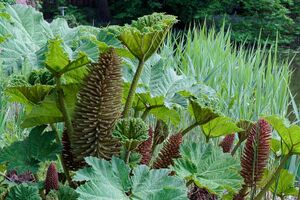Gunnera Cyanobacteria symbiosis: Difference between revisions
No edit summary |
No edit summary |
||
| Line 7: | Line 7: | ||
Cyanobacteria are the largest phylum of Gram-positive prokaryotes on earth. They are known for their ability to obtain energy through photosynthesis <ref>[https://www.sciencedirect.com/science/article/pii/S0168945207003202?via%3Dihub Sinha, R. P., & Häder, D. P. (2008). UV-protectants in cyanobacteria. <i>Plant Science</i>, 174(3), 278-289.]</ref>. The ability to produce oxygen is believed to be an attribute to their success in evolution because the environment in which they were developing was otherwise occupied by anaerobic bacteria <ref>[https://books.google.com/books?hl=en&lr=&id=4oJ_vi27s18C&oi=fnd&pg=PR3&dq=Whitton+BA,+ed.+(2012).+%22The+fossil+record+of+cyanobacteria%22.+Ecology+of+Cyanobacteria+II:+Their+Diversity+in+Space+and+Time.+Springer+Science+%26+Business+Media.+pp.+17%E2%80%93.+&ots=JG1mYJsMTT&sig=yuPO7pmok3mkSV5sDkrOn0uGc4U#v=onepage&q=Whitton%20BA%2C%20ed.%20(2012).%20%22The%20fossil%20record%20of%20cyanobacteria%22.%20Ecology%20of%20Cyanobacteria%20II%3A%20Their%20Diversity%20in%20Space%20and%20Time.%20Springer%20Science%20%26%20Business%20Media.%20pp.%2017%E2%80%93.&f=false Whitton, B. A. (Ed.). (2012). <i>Ecology of cyanobacteria II: their diversity in space and time</i>. Springer Science & Business Media.]</ref>. | Cyanobacteria are the largest phylum of Gram-positive prokaryotes on earth. They are known for their ability to obtain energy through photosynthesis <ref>[https://www.sciencedirect.com/science/article/pii/S0168945207003202?via%3Dihub Sinha, R. P., & Häder, D. P. (2008). UV-protectants in cyanobacteria. <i>Plant Science</i>, 174(3), 278-289.]</ref>. The ability to produce oxygen is believed to be an attribute to their success in evolution because the environment in which they were developing was otherwise occupied by anaerobic bacteria <ref>[https://books.google.com/books?hl=en&lr=&id=4oJ_vi27s18C&oi=fnd&pg=PR3&dq=Whitton+BA,+ed.+(2012).+%22The+fossil+record+of+cyanobacteria%22.+Ecology+of+Cyanobacteria+II:+Their+Diversity+in+Space+and+Time.+Springer+Science+%26+Business+Media.+pp.+17%E2%80%93.+&ots=JG1mYJsMTT&sig=yuPO7pmok3mkSV5sDkrOn0uGc4U#v=onepage&q=Whitton%20BA%2C%20ed.%20(2012).%20%22The%20fossil%20record%20of%20cyanobacteria%22.%20Ecology%20of%20Cyanobacteria%20II%3A%20Their%20Diversity%20in%20Space%20and%20Time.%20Springer%20Science%20%26%20Business%20Media.%20pp.%2017%E2%80%93.&f=false Whitton, B. A. (Ed.). (2012). <i>Ecology of cyanobacteria II: their diversity in space and time</i>. Springer Science & Business Media.]</ref>. | ||
Many species live in large colonies of cells ranging from hundreds to thousands of cells in a single colony <ref>[https://www.ncbi.nlm.nih.gov/pmc/articles/PMC3138769/ Tamulonis, C., Postma, M., & Kaandorp, J. (2011). Modeling filamentous cyanobacteria reveals the advantages of long and fast trichomes for optimizing light exposure. <i>PLoS One</i>, 6(7), e22084.]</ref>. These colonies are able to form filaments, sheets, or hollow spheres <ref>[https://internal-journal.frontiersin.org/articles/10.3389/fmicb.2021.631654/full Aguilera, A., Klemenčič, M., Sueldo, D. J., Rzymski, P., Giannuzzi, L., & Martin, M. V. (2021). Cell death in Cyanobacteria: current understanding and recommendations for a consensus on its nomenclature. Frontiers in Microbiology, 12, 416.</ref>. These colonies, when too large, can form harmful algal blooms that can cause great harm to the aquatic ecosystem and the surrounding area it is in (Pearl and Otten). | Many species live in large colonies of cells ranging from hundreds to thousands of cells in a single colony <ref>[https://www.ncbi.nlm.nih.gov/pmc/articles/PMC3138769/ Tamulonis, C., Postma, M., & Kaandorp, J. (2011). Modeling filamentous cyanobacteria reveals the advantages of long and fast trichomes for optimizing light exposure. <i>PLoS One</i>, 6(7), e22084.]</ref>. These colonies are able to form filaments, sheets, or hollow spheres <ref>[https://internal-journal.frontiersin.org/articles/10.3389/fmicb.2021.631654/full Aguilera, A., Klemenčič, M., Sueldo, D. J., Rzymski, P., Giannuzzi, L., & Martin, M. V. (2021). Cell death in Cyanobacteria: current understanding and recommendations for a consensus on its nomenclature. Frontiers in Microbiology, 12, 416.] </ref>. These colonies, when too large, can form harmful algal blooms that can cause great harm to the aquatic ecosystem and the surrounding area it is in (Pearl and Otten). | ||
Revision as of 12:45, 5 November 2021
Gunnera

Cyanobacteria
Cyanobacteria are the largest phylum of Gram-positive prokaryotes on earth. They are known for their ability to obtain energy through photosynthesis [1]. The ability to produce oxygen is believed to be an attribute to their success in evolution because the environment in which they were developing was otherwise occupied by anaerobic bacteria [2].
Many species live in large colonies of cells ranging from hundreds to thousands of cells in a single colony [3]. These colonies are able to form filaments, sheets, or hollow spheres [4]. These colonies, when too large, can form harmful algal blooms that can cause great harm to the aquatic ecosystem and the surrounding area it is in (Pearl and Otten).
Section 2 Microbiome
Include some current research, with a second image.
Conclusion
Overall text length (all text sections) should be at least 1,000 words (before counting references), with at least 2 images.
Include at least 5 references under References section.
References
- ↑ Sinha, R. P., & Häder, D. P. (2008). UV-protectants in cyanobacteria. Plant Science, 174(3), 278-289.
- ↑ Whitton, B. A. (Ed.). (2012). Ecology of cyanobacteria II: their diversity in space and time. Springer Science & Business Media.
- ↑ Tamulonis, C., Postma, M., & Kaandorp, J. (2011). Modeling filamentous cyanobacteria reveals the advantages of long and fast trichomes for optimizing light exposure. PLoS One, 6(7), e22084.
- ↑ Aguilera, A., Klemenčič, M., Sueldo, D. J., Rzymski, P., Giannuzzi, L., & Martin, M. V. (2021). Cell death in Cyanobacteria: current understanding and recommendations for a consensus on its nomenclature. Frontiers in Microbiology, 12, 416.
Edited by Rachael Tomasko, student of Joan Slonczewski for BIOL 116 Information in Living Systems, 2021, Kenyon College.
